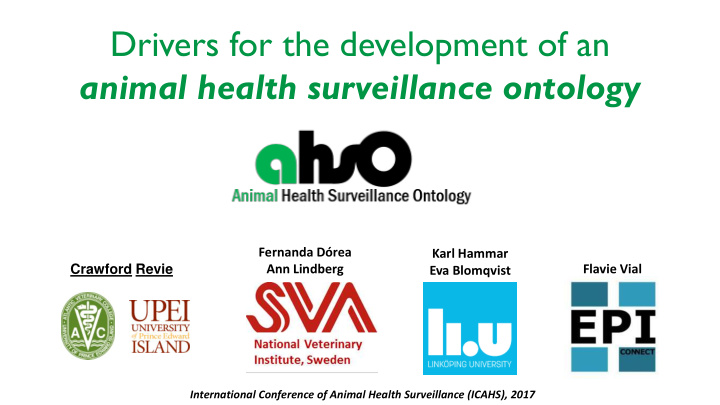



Drivers for the development of an animal health surveillance ontology Fernanda Dórea Karl Hammar Ann Lindberg Flavie Vial Crawford Revie Eva Blomqvist International Conference of Animal Health Surveillance (ICAHS), 2017
An ontology defines a common vocabulary for users who need to share information within a domain. It includes machine-interpretable definitions of basic concepts in the domain and relations among them.
VeNom (Veterinary Nomeclature) • Different 'Squamous cell carcinoma - clitoral' 'Squamous cell carcinoma - conjunctival' dimensions of 'Squamous cell carcinoma - corneal' knowledge 'Squamous cell carcinoma - gastric (stomach)' 'Squamous cell carcinoma - penis/prepuce' contained in the 'Squamous cell carcinoma - oesophageal' 'Squamous cell carcinoma - nasal sinus' data 'Squamous cell carcinoma - perineal' 'Squamous cell carcinoma - third eyelid/nictitating membrane' 'Squamous cell carcinoma - urethral' 'Squamous cell carcinoma - urinary bladder'
MeSH Terms • Different dimensions of knowledge contained in the data
Wine Wine • Different Red Sparkling dimensions of White Wine knowledge Non- contained in the sparkling Sparkling Rose Red Non- data sparkling Sparkling White Non- sparkling Rose Sparkling Non- sparkling
Ontologies • Data model • Classes • Properties • Instances
Why use ontologies?
To share common understanding of the structure of information among people or software agents
To enable reuse of domain knowledge Ontology for General Medical Uberon Science multi-species anatomy ontology Symptom Ontology Anatomical Entity Ontology Clinical Measurement Foundational Ontology GO Model of Gene Ontology Anatomy
To re-use domain independent knowledge Geonames (‘GIS’) schema.org Ontology FOAF (‘people’) Ontology SKOS (‘ Thesuaral ’ structure) Ontology
To make domain assumptions explicit
To support research and knowledge discovery from data Osteochondroma of Fracture of the femur femur All injuries of the femur? All injuries of the LEG?
Ontologies applied to data-driven surveillance
Desired functions • Convert health data into information in real-time • Use medical knowledge to infer surveillance relevant information from data collected for other purposes • Provide a permenant source of term mappings that are open and can be shared/expanded by community ( IRI )
Inherent challenges to overcome • Distributed data (not likely to be shared) • Data non-coded or coded using different standards • Solutions must work prospectively and retrospectively
Sustainability of solutions • Maintenance • Reviews and updates • Scalability • Transparency • Interoperability
Module 3 – Abattoir laboratory data data Module 1 – animal registry Module 2 – clinical data VeNom https://w3id.org/ahso
Workflow for each data source Data Fill the Concepts model gaps Improve / expand
Community involvement • Workgroups for each module/data type • Review outputs and submit issues • Google forum • Github datadrivensurveillance.org/ahso • Home page • Open edit book
Challenge to ‘big data’ epi teams • microdata • JSON-LD • schema.org • RDF • OWL
Just when you thought it was safe to be a quantitative epidemologist
datadrivensurveillance.org/ahso https://w3id.org/ahso
Recommend
More recommend